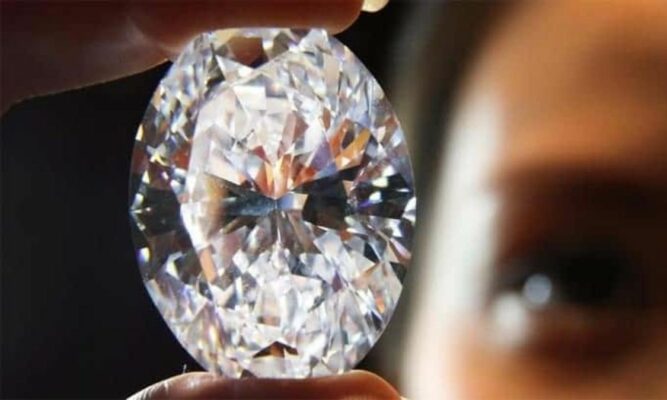Let me begin by saying diamonds are forever.
They are one of the finest pieces of jewelries in the world. Those who can afford it would always love to buy a piece of this magnificent beauty.
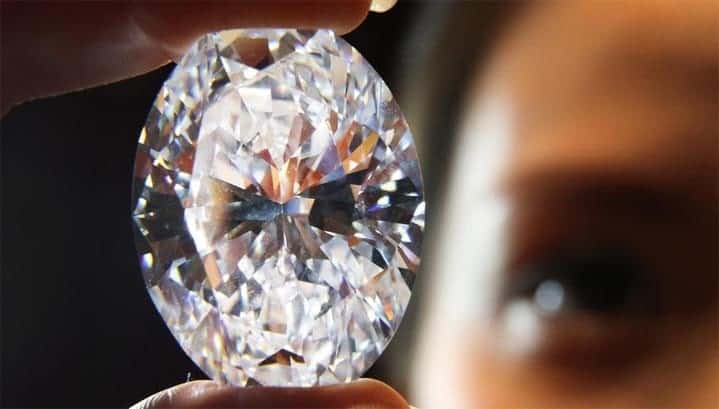
If you are planning to buy a diamond ring, earring or necklace, then you must read the entire article.
Buying a diamond is not like running your daily errands like grocery shopping or ordering a pizza.
Before buying it you have to undergo a crash course about diamonds.
You need to get familiar with myriads of small details. Otherwise you will end up losing thousands of dollars for just one small piece of diamond.
So if you don’t want to get ripped off then do read this article.
Don’t make any knee-jerk decisions.
Basics of Diamonds that You Need to Know
Let us begin with learning basics of diamonds. I will try my best to keep it simple especially for people who know nothing about diamonds.
There are 4 Cs and 1 S to a diamond. If a piece of diamond is given to you then you will look that particular piece for 4 Cs and 1 S.
Let us begin with 4 Cs.
1. Cut
Out of 4 Cs cut is the first one and most important. Yes, cut is the most important feature that you will look in a diamond.
Cut determines how good a diamond sparkles.
If a diamond is poorly cut, then it may appear dull with less shine.
Even if a diamond has a perfect clarity and of high color grade (you will learn later in the article) it can appear dull if it is poorly cut.
Cut can be graded into five categories.
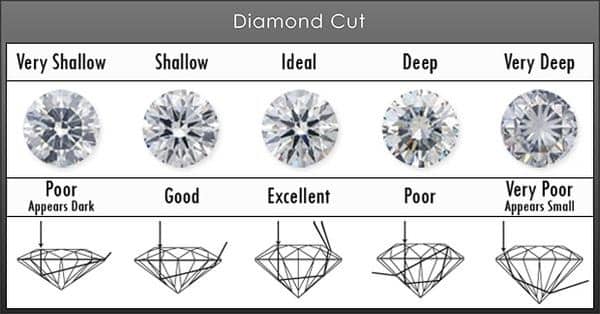
- Poor/Fair: 35% of the diamonds in the market are Poor/Fair cut. They appear quite dull.
- Good: 25% of the diamonds can be graded for good cut.
- Very Good: 15% of the diamonds are of Very Good cut grade. They shine just like ideal cut grade diamond but come with a lower price.
- Ideal: Only 3% of diamonds are of Ideal cut. It reflects most of the light and shines very bright.
- Signature: Only 1% are of signature cut and shines better than Ideal cut diamond.
2. Color
After cut second most important characteristic is color of the diamond.
Colorless diamonds are the most expensive ones.
Let us see the color grade for diamonds.
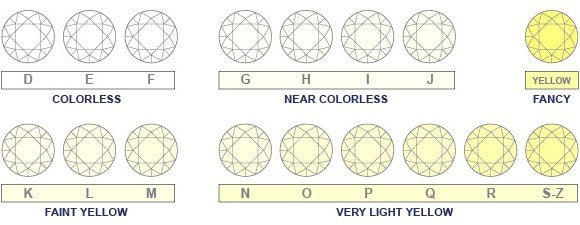
“Colorless” D through F
1. Grade D – D is the highest color grade and they are absolutely colorless. They are the most expensive ones.
2. Grade E – Second best diamonds are of Grade E. Expert gemologists can detect traces of color under the microscope. Price is less than Grade D diamonds.
3. Grade F – Traces of color are slightly more than Grade E diamonds.
“Near Colorless” G through J
4. Grade G – It is difficult to detect color.
5. Grade H – Just as Grade G diamond.
6. Grade I – Traces are slightly detectable.
7. Grade J – Just like Grade I diamond.
“Noticeable Color” K through Z
8. Grade K – Z – They have noticeable color. The cost of diamond decreases as you move from K towards Z.
As you move from color grade D to Z price will decrease.
Diamonds of color Grade A, B, C are still not discovered and if they are then they will be the most expensive diamonds in the world.
3. Clarity
Clarity is the third most important factor to consider for a diamond.
Cut and Color of a diamond can be seen from naked eye but for clarity you have to put the diamond under the microscope.
Tiny imperfections within the diamonds determines the clarity. These imperfections or blemishes are also known as inclusions. More the inclusions lesser the quality of a diamond. Lesser the inclusions greater the quality of the diamond.
These imperfections or inclusions can’t be seen from naked eyes and are seen under a microscope by an expert gemologist.
Grading Scale

1. FL – FL or Flawless diamonds are rare quality diamonds with no visible blemishes even under 10X magnifications. Only less than 1% diamonds in the market are of FL grade.
2. IF – IF or Internally Flawless have small blemishes but difficult to see under 10X magnifications. Only less than 3% diamonds in the market are of IF grade.
3. VVS1 – VVS1 or Very, very slightly included have inclusions (blemishes) in the bottom half (also known as pavilion) of the diamond.
4. VVS2 – VVS2 is the same thing as VVS1 here inclusions are in the top half (also known as crown) of the diamond.
5. VS1 – VS1 or Very Slightly included diamonds have blemishes that can be seen under 10X magnifications.
6. VS2 – VS2 has more blemishes than VS1.
7. SI1 – SI1 or Slightly Included have blemishes that can be seen from naked eye.
8. SI2 – SI2 diamonds are same as SI1.
9. I1 – Loose diamonds with inclusions quite visible to naked eye.
10. I3-I2 – Even more inclusions than I1.
FL grade diamonds are the costliest diamonds in the market. As you move down from FL to I3 cost decreases.
4. Carat
The fourth feature is Carat. Carat is the standard unit for weighing diamonds. 1 Carat is equal to 200 milligrams or 1/5th of a gram or 0.2 gram.

Carat is the weight of a diamond and not the size.
A smaller carat weight diamond can appear larger in size because of higher cutting grade.
The price of the diamond increases with the carat weight.
You have to refer the diamond carat chart for finding out the appearance of a diamond with different carat weights and shapes.
So these were 4 Cs that you need to know.
Certification
Actually there is one more C that I would like to add and that is certification. 
NEVER buy a diamond unless it is certified by GIA (Gemological Institute of America).
Whichever retailer you are buying your diamond from. You need to ask the retailer about the certification from GIA.
Do not fall for in house certification ordered by the retailer. Simply don’t accept any other certification.
If you are not asking the retailer for GIA before buying a diamond, then you may end up buying a poor quality diamond.
Certification, the final C is very important. So it is actually 5 Cs.
1 S is Shape
Shape
Diamonds comes in all shapes and sizes. Here are some of the shapes you need to know.
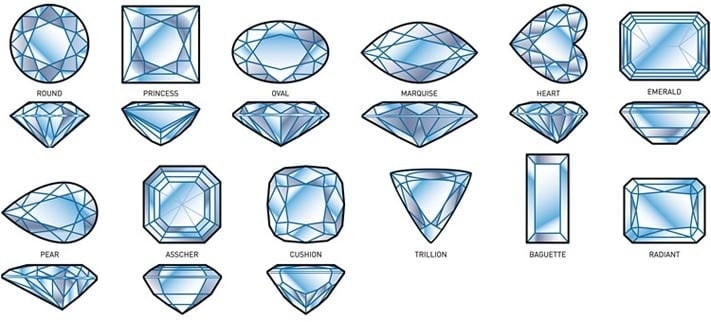
- Round: They are the most popular diamonds in the market.
- Princess: A Non round diamond.
- Emerald: It gives higher clarity.
- Marquise: It can maximize carat weight.
- Oval: Similar to round diamonds.
- Radiant: They come with trimmed corners.
- Pear: Single Point and rounded end.
- Cushion: They have larger facets to increase brilliance.
So this is all the education you need to learn about a diamond. However still this is not enough for choosing a diamond that you can buy.
How to Choose a Diamond? – An Ideal Combination
You need to choose a diamond keeping 4 Cs and 1 S in mind before you finally buy it. In order to choose a diamond, you have to look for an ideal combination of 4 Cs and 1 S.
Here is the step by step guide that you need to follow for choosing a diamond.
Step 1: Shape
Start with choosing a shape of a diamond that you like the most. If you have a preference, then go for it.
Otherwise you can go for either round or princess shape because they are the most popular shapes in the market.
Choosing a shape would not be difficult for you.
Step 2: Carat
The second step would be deciding the carat. How much your diamond is going to weigh?
You have to choose carat weight between 0.25 and 5 carats.
Choosing the carat weight would depend upon your budget. If you have budget for 1 carat, then go for it.
Always remember if you are buying a 1.9 carat diamond instead of 2 carats then you save a lot of money.
Step 3: Clarity
The third step is clarity. If the budget is not your consideration, then go for VVS1 or VVS2. About 10% of diamonds fall under this category.
However, the most popular clarity range which people buy is VS1 and VS2. They are the best bet considering your budget. The clarity is also good as blemishes can’t be seen through naked eyes. If you want to buy a diamond over 2 carats then go for VS2.
If you are really low on budget then you should go for SI1. You can buy 1 carat diamond with S1 or S2 clarity grade. You can compromise the higher cut and color grade for SI1 grade clarity. 30% of diamonds fall under SI1 and SI2 grade system.
A 1 carat SI2 diamond is half price of VS1 diamond.
Third option is for buyers who are on very, very low budget. They can go for I1. Blemishes can be seen from naked eyes but the size of the diamond is large and price is very low.
Step 4: Color
Carat and Clarity can’t be judged by the naked eye. However, color of a diamond can be seen from a naked eye.
To get most out of the deal you have to choose a right colored diamond for the least price.
If you have enough budget, then you can go for a colorless diamond (if you see from naked eyes) ranging from G to J.
If you want to buy a diamond over 1 carat then go for color range G to H and for under 1 carat go for I to J color grade.
But if your hand is tight then you have to go for diamonds of K-L color grade.
You also have to keep shape and cut of the diamond in your mind. For example, diamonds with larger facet area reflect more light hence hide color. If you talk about shape then go for round or princess shape diamonds.
Step 5: Cut
Cut is the most important feature that you have to look into before you buy a diamond.
There is no standard grading system for cut like we have for Carat, Clarity and Color of any diamond.
Different retailers use different terminologies. Most common are Excellent, Very Good, Fair, Poor and others use terms like Signature Ideal, Ideal and Excellent. So it depends upon the retailer.
However always go for GIA (read in following paragraphs) cut grades.
As you know a poorly cut diamond will appear dull even with excellent clarity and color and vice versa.
If your budget is high, then for superior brilliance choose very good or excellent cut.
Similarly, for low budget you can go for Fair or Good cut for fancy shaped diamonds.
Finally, I would say you can save a lot of money on carat. It is because if you buy a diamond with 10% less carat you will save a lot of money and 10% less carat would not make any difference seeing from the naked eye.
So you have to keep above mentioned factors in your mind so you get a right combination, most shiny diamond at a lower price.
Looking at Final Price Chart Before Buying a Diamond
In order to simplify the last paragraph, I am giving you a price chart to compare for all 4C’s and get the best combination.
The diamond price chart is also known as Rapaport Price list. The chart is the combination of 4 C’s.
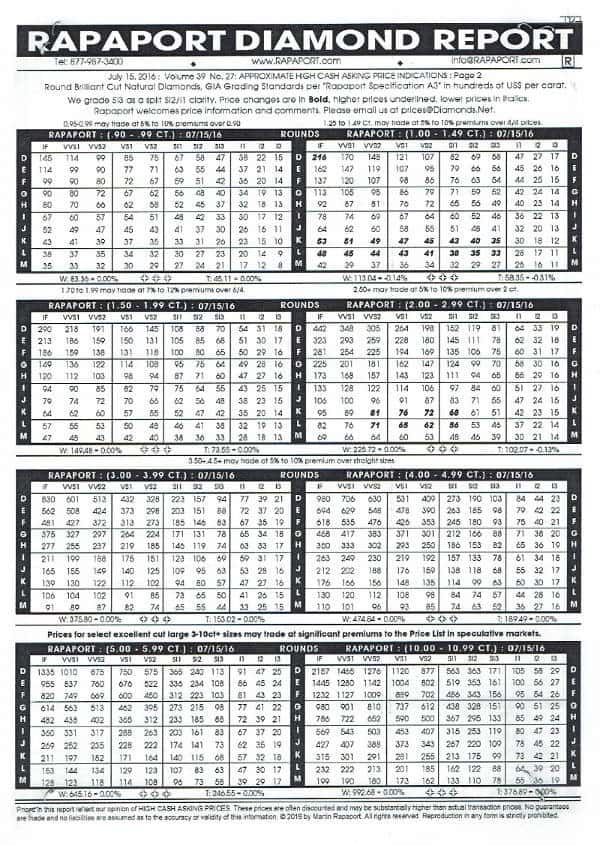
Chart is two dimensional matrix for different prices and carats.
The rows of the chart are diamond's color and the columns are clarity.
In order to find a value, you just have to look for a chart for weight/carat and then compare the rows (color) with columns (clarity).
You get the result. If the result is 75 then it means the price of the diamond for that particular weight is $7500. If the value is 45 then price is $4500.
However, the chart does not take in account other factors like cut quality and fluorescence.
So the Price Chart is not a final thing, you still have to do more research before you buy a diamond.
As they say, you don’t get all the knowledge reading a book. You have to get real on ground experience.
Return on Your Investment in Diamonds
If you don’t want to buy diamond as a piece of jewelry like rings or earrings, then you can buy it as a great investment opportunity.
There are many advantages of investing in Diamonds.
The first one is, they appreciate like other commodities gold, silver even real estate.
So you will get more value years after you invested. You are not going to lose any money.
Moreover, diamond don’t age and you don’t have to worry about maintenance because they are hardest substance on the planet.
So there is no reason why you should not invest in diamonds.
Set a budget and start investing in diamonds.
You should diversify your investment by buying all kinds of diamonds. Buy as many as diamonds for a given budget range.
For example, if your budget is around $30,000 then buy 3 to 4 different diamonds instead of buying just one.
Always compare prices and look for the GIA certification.
Keep the diamonds with you and sell them at the right time.
So this is all you need to know about buying a diamond.
I expect you to read this article, understand the basics and then think of buying a diamond.
Don’t buy a diamond in haste. Take your time before you make a move.
If you have any doubt, then read this article again and again.
Enquire your nearby retailer and then finally buy the diamond.

He began his journey with affiliate marketing in 2004 and has since built multiple 7-figure online businesses through blogging, SEO, and automation.
With over 14 years of experience in content and more than 3 years specializing in AI automations and AI agents, Pritam now helps businesses and solopreneurs automate their operations, generate leads, and scale effortlessly using AI-powered systems.
Through his training and tutorials, he has empowered thousands to turn automation into income — making him a trusted voice in India’s growing AI and automation space.

